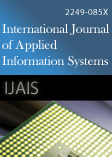
- Mahmoud Abdelaziz and Amr Badr and Ibrahim Farag 2012. Membrane Computing as Multi Turing Machines. International Journal of Applied Information Systems. 4, 8 (December 2012), 7-11. DOI=http://dx.doi.org/10.5120/ijais450764
-
@article{10.5120/ijais2017451568, author = {Mahmoud Abdelaziz and Amr Badr and Ibrahim Farag}, title = {Membrane Computing as Multi Turing Machines}, journal = {International Journal of Applied Information Systems}, issue_date = {December 2012}, volume = {4}, number = {}, month = {December}, year = {2012}, issn = {}, pages = {7-11}, numpages = {}, url = {/archives/volume4/number8/376-0764}, doi = { 10.5120/ijais12-450764}, publisher = { xA9 2012 by IJAIS Journal}, address = {} } -
%1 450764 %A Mahmoud Abdelaziz %A Amr Badr %A Ibrahim Farag %T Membrane Computing as Multi Turing Machines %J International Journal of Applied Information Systems %@ %V 4 %N %P 7-11 %D 2012 %I xA9 2012 by IJAIS Journal
Abstract
A Turing machine (TM) can be adapted to simulate the logic of any computer algorithm, and is particularly useful in explaining the functions of a CPU inside a computer. Membrane computing aims to develop models and paradigms that are biologxACically motivated. It identifies an unconventional computing model, namely a P system, which abstracts from the way living cells process chemical compounds in their compartmental structure. These systems are a class of distributed systems, maxixACmally parallel computing devices of a biochemical type. In this research, the research tries investigating a new view to show Membrane computing is a multi TM that communicate with each other. The main idea is that each membrane is a TM itself and each TM can communicate with other TM through communication channels under the structure of membranes (tree membranes structure) where membrane (TM) can send and receive string (multiset) to or from other membrane (TM). This TM is a TM with three tapes.
References
- J. Copeland, "The Blackwell Guide to the Philosophy of Computing and Information" Blackwell, 2003.
- G. P?un. "Membrane Computing, Basic ideas, Results, Applications" Pre-Proceeding of First International Workshop on Theory and Application of P Systems, Timisoara (Romania), 2005.
- G. P?un. "Computing with membranes" In Turku University Computer ScixACence Research Report No. 208, 1998.
- John Hopcroft, Jeffrey Ullman, Introduction to Automata Theory, Languages, and Computation, Addison-Wesley 1979.
- Dina Goldin, Peter Wegner, Persistent Turing Machines, Brown University Technical Report, 1998.
- L. FernxE1ndez, F. Arroyo, J. Castellanos. et al (2006) " New Algorithms for Application of Evolution Rules based on Applicability Benchmarks " Las Vegas (USA).
- Tejedor, J, L. FernxE1ndez, F. Arroyo, et al (2007) "Algorithm of Active Rules Elimination for Application of Evolution Rules" 8th WSEAS, Vancouver (Canada), 2007.
- C. Li, Validating P system as Distributed Computing Models, master thesis, 2008.
- G. Ciobanu, Distributed Algorithms over Communication Membrane Systems, Bio Systems, 70(2):123-133, 2003.
- Peter Wegner, Interactive Foundations of Computing, Theoretical Computer Science, Feb. 1998.
- Peter Wegner, Dina Goldin, Coinductive Models of Finite Computing Agents, Proc. Coalgebra Workshop (CMCS '99), Electronic Notes in Theoretical Computer Science, Vol. 19, March 1999.
Keywords
Membrane computing, Turing machine, Persistent Turing Machines
 10.5120/ijais12-450764
10.5120/ijais12-450764
